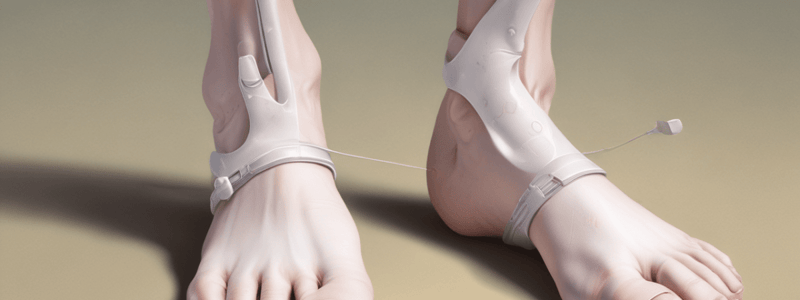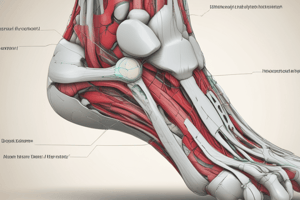Podcast
Questions and Answers
Which accessory ossicle becomes apparent radiographically at ages 9-11?
Which accessory ossicle becomes apparent radiographically at ages 9-11?
- Talar prominence
- Accessory scaphoid (correct)
- Navicular prominence
- Ganglionic cyst
What type of accessory ossicle is classified as a true sesamoid because it is within the tendon?
What type of accessory ossicle is classified as a true sesamoid because it is within the tendon?
- Exostosis
- Navicular prominence
- True accessory scaphoid (correct)
- Talar prominence
Which condition can reduce the talar prominence?
Which condition can reduce the talar prominence?
- Pathomechanical deformity (correct)
- Arthritis
- Periosteal reaction
- Ganglionic cyst
What is virtually unaffected by subtalar joint motion near the navicular prominence?
What is virtually unaffected by subtalar joint motion near the navicular prominence?
Which soft tissue condition is NOT typically associated with the medial foot prominences?
Which soft tissue condition is NOT typically associated with the medial foot prominences?
What represents an extension of the navicular and has a connection represented by a radiolucent zone?
What represents an extension of the navicular and has a connection represented by a radiolucent zone?
What is the usual treatment for an accessory navicular that causes symptoms?
What is the usual treatment for an accessory navicular that causes symptoms?
What is a common cause of irritation related to Os Trigonum?
What is a common cause of irritation related to Os Trigonum?
In what age range does the Os Trigonum usually unite or fuse with the talus?
In what age range does the Os Trigonum usually unite or fuse with the talus?
What surgical intervention was performed on the 32-year-old male with a painful left ankle?
What surgical intervention was performed on the 32-year-old male with a painful left ankle?
What treatment method was found to be ineffective for the 32-year-old male with a painful left ankle upon his return 1 year later?
What treatment method was found to be ineffective for the 32-year-old male with a painful left ankle upon his return 1 year later?
What type of surgical treatment was performed on the 47-year-old male with a chronic ulcer sub IPJ?
What type of surgical treatment was performed on the 47-year-old male with a chronic ulcer sub IPJ?
What is the primary procedure of choice for treating a talar prominence?
What is the primary procedure of choice for treating a talar prominence?
What is a conservative initial treatment option for navicular prominences?
What is a conservative initial treatment option for navicular prominences?
Which surgical approach is used for Type I accessory navicular surgeries?
Which surgical approach is used for Type I accessory navicular surgeries?
What is recommended to visualize the entire tuberosity in Type II accessory navicular surgeries?
What is recommended to visualize the entire tuberosity in Type II accessory navicular surgeries?
For Type III accessory navicular surgeries, what should be done to protect the articular surface of the talar head during resection of the tuberosity?
For Type III accessory navicular surgeries, what should be done to protect the articular surface of the talar head during resection of the tuberosity?
Which adjunctive procedure may need to be considered when treating a talar prominence?
Which adjunctive procedure may need to be considered when treating a talar prominence?
What is the primary procedure of choice for treating a navicular prominence?
What is the primary procedure of choice for treating a navicular prominence?
Which accessory ossicle classification is considered to be a true carnuate navicular or enlarged navicular tuberosity?
Which accessory ossicle classification is considered to be a true carnuate navicular or enlarged navicular tuberosity?
What surgical intervention involves reflecting the posterior tibialis from the talonavicular joint capsule to remove the ossicle?
What surgical intervention involves reflecting the posterior tibialis from the talonavicular joint capsule to remove the ossicle?
Which conservative initial treatment option may be used for navicular prominences?
Which conservative initial treatment option may be used for navicular prominences?
What is the common radiographic presentation of a Type II accessory navicular?
What is the common radiographic presentation of a Type II accessory navicular?
What adjunctive procedure may need to be considered when treating a talar prominence?
What adjunctive procedure may need to be considered when treating a talar prominence?
What soft tissue condition is typically associated with the medial foot prominences?
What soft tissue condition is typically associated with the medial foot prominences?
In which direction is the talus prominence exaggerated?
In which direction is the talus prominence exaggerated?
What age range typically sees the accessory navicular becoming radiographically apparent?
What age range typically sees the accessory navicular becoming radiographically apparent?
What is the primary characteristic that distinguishes a Type I accessory navicular?
What is the primary characteristic that distinguishes a Type I accessory navicular?
Which movement contributes to a reduction in the talar prominence?
Which movement contributes to a reduction in the talar prominence?
What pathological condition involves a prominence produced by the head of the talus?
What pathological condition involves a prominence produced by the head of the talus?
What is the typical presentation of pain in patients with an extremely large tuberosity at the base of the 5th metatarsal?
What is the typical presentation of pain in patients with an extremely large tuberosity at the base of the 5th metatarsal?
What distinguishes the Os Vesalianum from other symptomatic accessory ossicles?
What distinguishes the Os Vesalianum from other symptomatic accessory ossicles?
In what location is the Os Peroneus accessory bone typically found?
In what location is the Os Peroneus accessory bone typically found?
Which scenario would most likely prompt surgical intervention for symptomatic accessory bones of the foot?
Which scenario would most likely prompt surgical intervention for symptomatic accessory bones of the foot?
When would resection of osteophytic changes be most likely necessary in the treatment of accessory bones of the foot?
When would resection of osteophytic changes be most likely necessary in the treatment of accessory bones of the foot?
What is a key characteristic that distinguishes OS VESALIANUM from other symptomatic ossicles?
What is a key characteristic that distinguishes OS VESALIANUM from other symptomatic ossicles?
What is the primary characteristic of Type V dorsal exostosis at the 1st met.-cuneiform joint?
What is the primary characteristic of Type V dorsal exostosis at the 1st met.-cuneiform joint?
Which type of dorsal bossing involves angular malalignment at the 1st met.-cuneiform joint?
Which type of dorsal bossing involves angular malalignment at the 1st met.-cuneiform joint?
What is the main etiological factor associated with dorsal bossing of the 1st tarsometatarsal joint in Type II?
What is the main etiological factor associated with dorsal bossing of the 1st tarsometatarsal joint in Type II?
Which type of Type IV dorsal bossing involves lis franc’s joint in addition to the 1st met.-cuneiform?
Which type of Type IV dorsal bossing involves lis franc’s joint in addition to the 1st met.-cuneiform?
What distinguishes Type II dorsal bossing from other types based on exostosis location?
What distinguishes Type II dorsal bossing from other types based on exostosis location?
Which condition may result in a secondary dorsal bossing of the 1st met-cuneiform joint?
Which condition may result in a secondary dorsal bossing of the 1st met-cuneiform joint?
What is the common cause of irritation related to Os Subfibulare?
What is the common cause of irritation related to Os Subfibulare?
What is a potential surgical intervention for a patient with an accessory boney process like Os Trigonum?
What is a potential surgical intervention for a patient with an accessory boney process like Os Trigonum?
What is the main cause of irritation related to Os Subtibiale?
What is the main cause of irritation related to Os Subtibiale?
What is the typical treatment approach for a patient presenting with an accessory navicular causing symptoms?
What is the typical treatment approach for a patient presenting with an accessory navicular causing symptoms?
In which scenario would a tendon transfer be a likely treatment option?
In which scenario would a tendon transfer be a likely treatment option?
Which accessory bone typically fuses with the talus by the age of 18?
Which accessory bone typically fuses with the talus by the age of 18?



